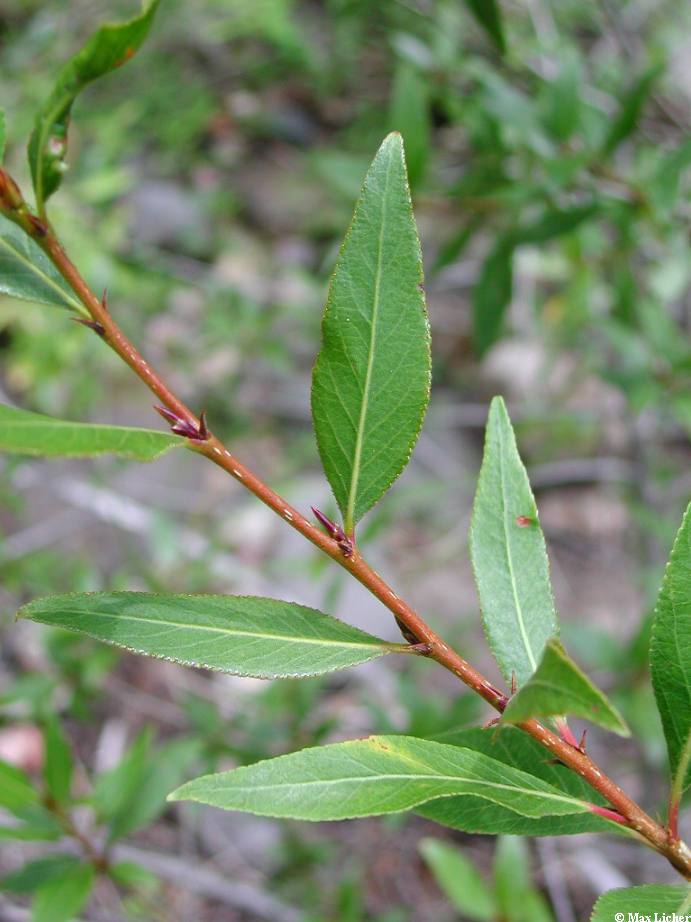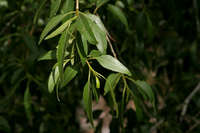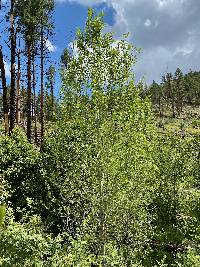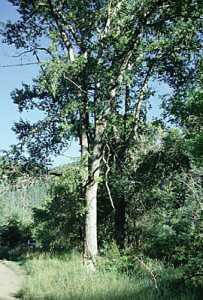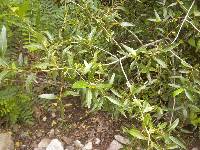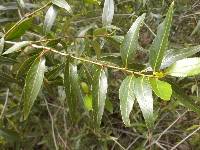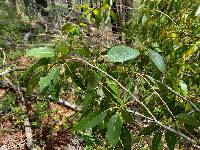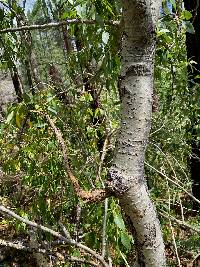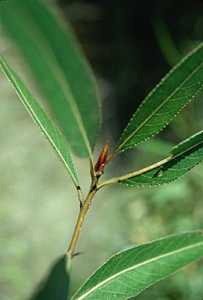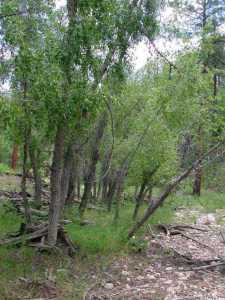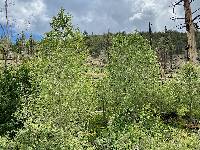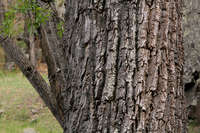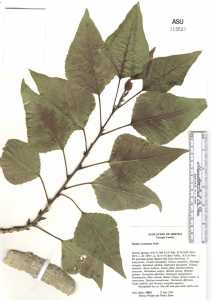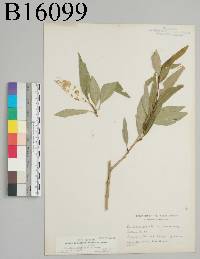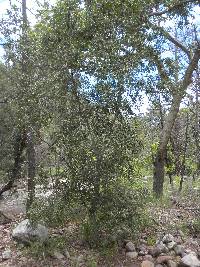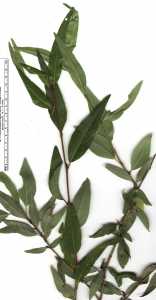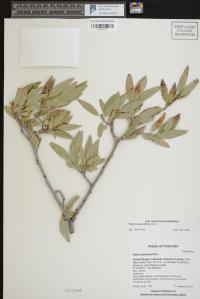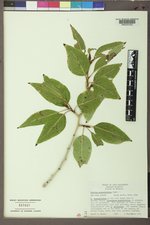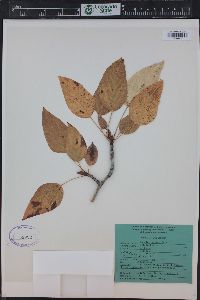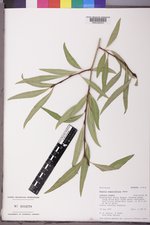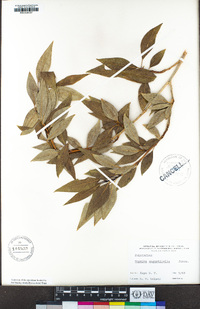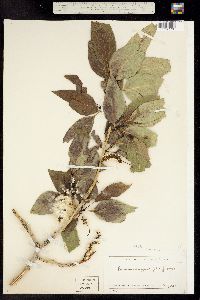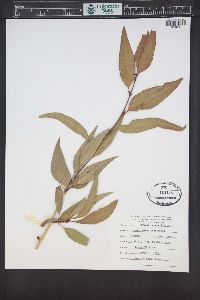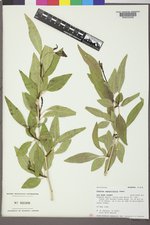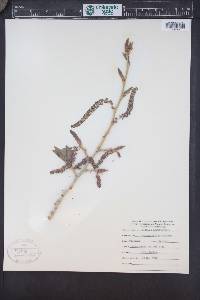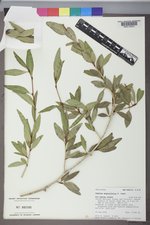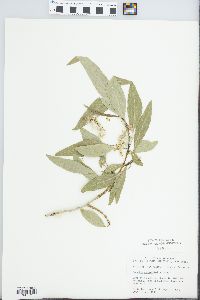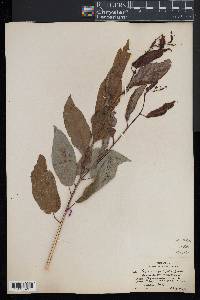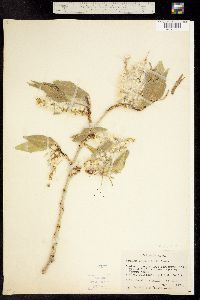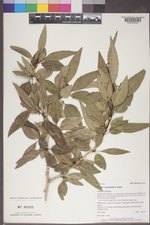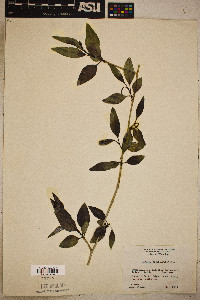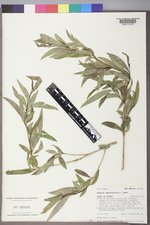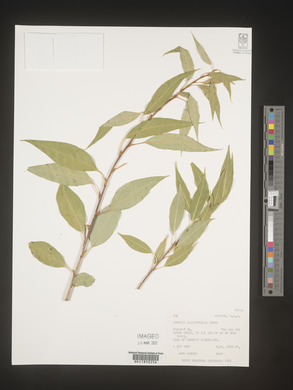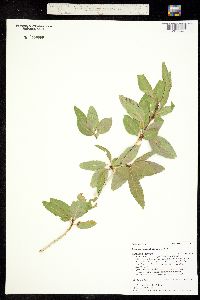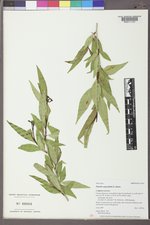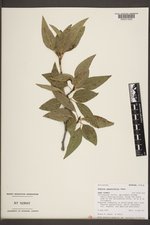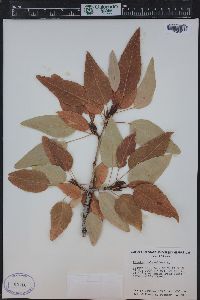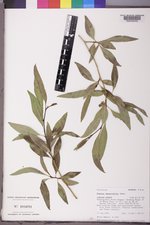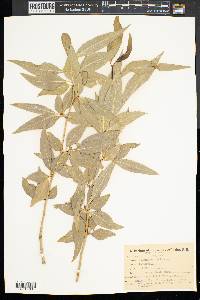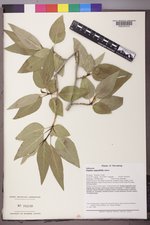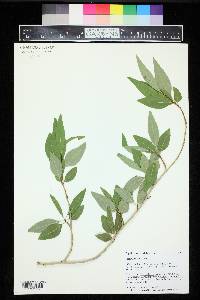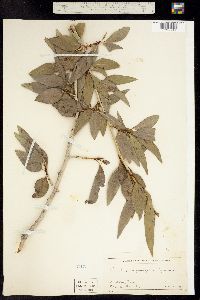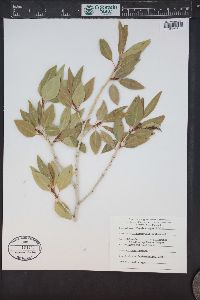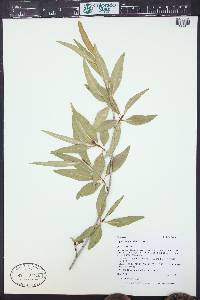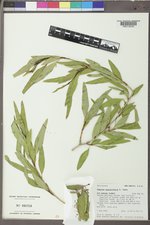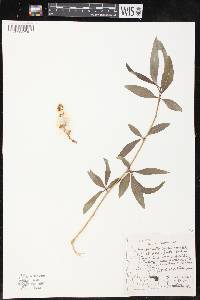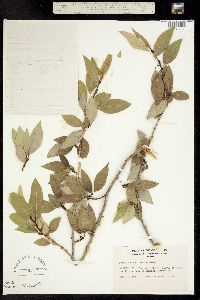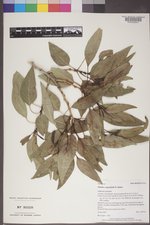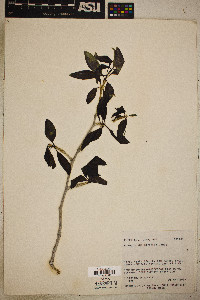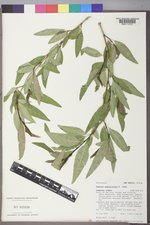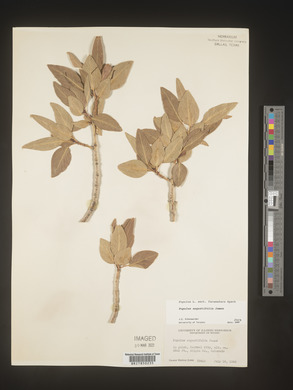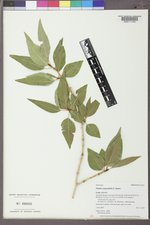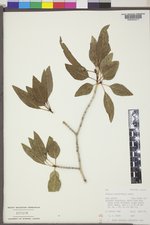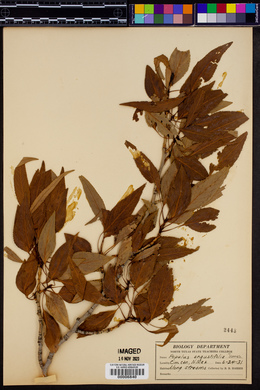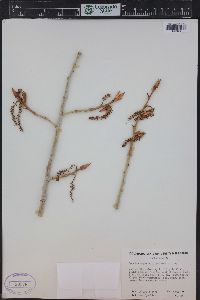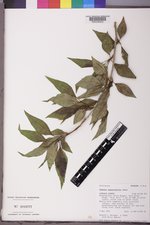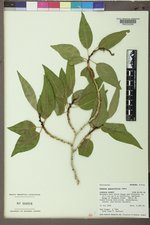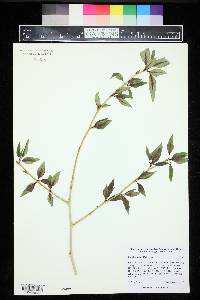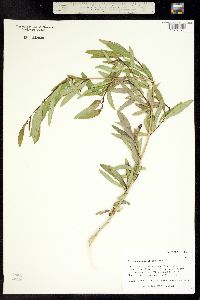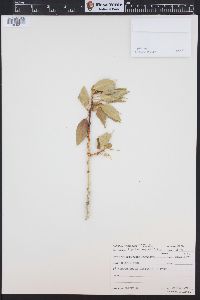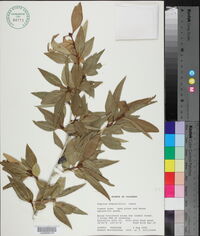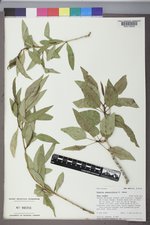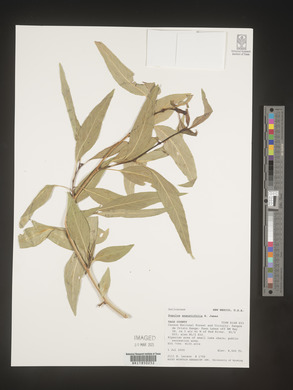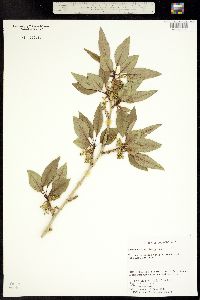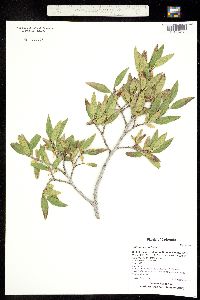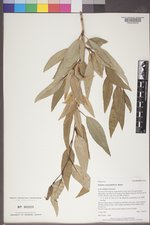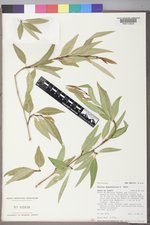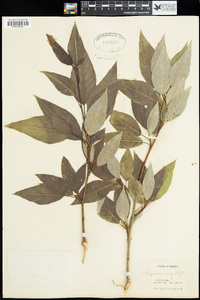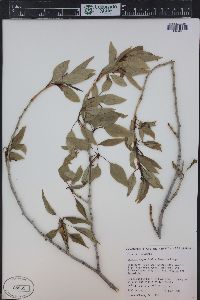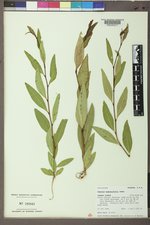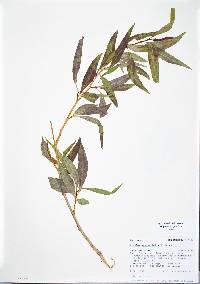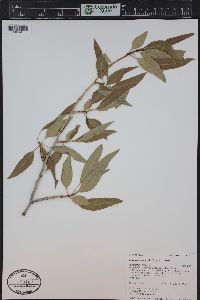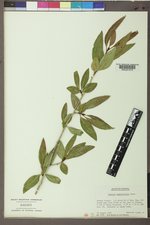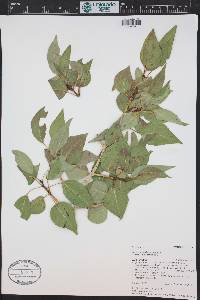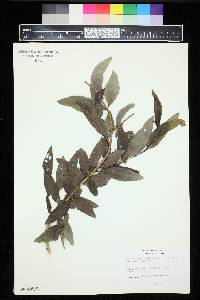Populus angustifolia
|
|
|
|
Family: Salicaceae
Narrow-Leaf Cottonwood, more...narrowleaf cottonwood
[Populus balsamifera var. angustifolia (James) S. Wats., morePopulus balsamifera var. augustifolia (E. James) S. Watson, Populus canadensis var. angustifolia (James) Wesmael, Populus fortissima A. Nels. & J.F. Macbr., Populus salicifolia Raf., Populus tweedyi Britt., Populus X sennii Boivin] |
Plants to 20 m, 7 dm diam.; moderately heterophyllous. Bark light brown, shallowly furrowed. Branchlets orange-brown, becoming whitish tan by third year, round or 5-angled, 1.5-2.5(-3.5) mm diam., not coarse, glabrous. Winter buds reddish brown, glabrous, resinous (resin red, fragrant); terminal buds (3-)6-9 (-13) mm; flowering buds clustered distally on branchlets, 8-12(-18) mm. Leaves: petiole round, adaxially slightly channeled distally, 0.2-0.8(-1.7) cm, 1/8-1/5 blade length, (glabrous); blade usually lanceolate to narrowly ovate, (1.5-)4-8(-13.5) × 0.8-2.5(-4) cm, w/l = 1/5-1/2, base acute to rounded, basilaminar glands 0, margins not translucent, not ciliate, apex acute, abaxial surface whitish green, weakly glaucous, adaxial dark green, glabrous; preformed blade margins subentire to minutely, evenly crenate-serrate throughout, teeth (14-)23-35(-65) on each side, sinuses 0.1-0.3 mm deep; neoformed blade margins finely crenate-serrate throughout, teeth 35-65(-80) on each side, sinuses 0.1-0.6(-1.5) mm deep. Catkins ± densely 35-50-flowered, 3-8(-9 in fruit) cm; floral bract apex deeply cut, not ciliate. Pedicels 0.5-1.5(-3 in fruit) mm. Flowers: discs shallowly cup-shaped, not obviously oblique, entire , 1-1.5(-3) mm diam.; stamens 10-20; anthers truncate; ovary 2-carpelled, ovoid to spherical; stigmas 2-4, broad, expanded. Capsules broadly ovoid to spherical, 3-5 mm, glabrous, 2-valved. Seeds (2-) 4-7(-9) per placenta. 2n = 38. Flowering Apr-May; fruiting Jun-Jul. Streamsides in mountains and foothills; 1500-2400(-3300) m; Alta., Sask.; Ariz., Colo., Idaho, Mont., Nebr., Nev., N.Mex., S.Dak., Tex., Utah, Wyo.; Mexico (Chihuahua, Coahuila, Sonora). Populus angustifolia has been mistakenly reported from eastern California and eastern Oregon based on intergrades with, and narrow-leaved specimens of, P. trichocarpa in those arid regions. It is a characteristic species of the Rocky Mountains, extending onto the plains and overlapping in canyon mouths as they exit the mountains with two North American species of sect. Aigeiros, P. deltoides and P. fremontii, and hybridizing with each of them. It also hybridizes with the other two native species of sect. Tacamahaca, P. balsamifera and P. trichocarpa. The hybrid with P. balsamifera, P. ×brayshawii B. Boivin, differs most obviously in longer petioles, at least 2.5 cm, and is increasingly common from Colorado northwards, largely replacing P. angustifolia in southern Alberta (T. C. Brayshaw 1965b; S. B. Rood et al. 1985). The hybrid with P. trichocarpa (unnamed) is uncommon and largely confined to the Great Basin region, including Montana (W. W. White 1951). Populus angustifolia does not hybridize naturally with P. tremuloides, as sometimes reported (B. Boivin 1966b). The specimens that formed the basis for that report are long shoots of P. angustifolia with relatively coarsely toothed neoformed leaves. Populus ×acuminata Rydberg is the intersectional hybrid of P. angustifolia with P. deltoides (sect. Aigeiros) that occurs on floodplains of major streams, primarily along the foot of the Rocky Mountain Front Ranges where these species grow together, but also extends onto the plains and Colorado Plateau (Alberta, Arizona, Colorado, Montana, Nebraska, New Mexico, North Dakota, South Dakota, Texas, Utah, and Wyoming) (J. E. Eckenwalder 1984). As with other cloning hybrids, it can often occur without one or both parents. It differs from P. angustifolia in larger, ovate leaves with coarser teeth, less color differentiation between abaxial and adaxial surfaces, and longer petioles that are slightly flattened side to side near the junction with the blade. Because of its frequency and morphological consistency, P. ×acuminata was first described as a species and is often treated as such in local and regional floras. It was long suspected of being a hybrid, and its hybrid origin was amply confirmed by multiple lines of evidence in the 1970s and 1980s (D. J. Crawford 1974; A. G. Jones and D. S. Seigler 1975; S. B. R Plant: tree; to 20 m tall, not clonal; bark tan, furrowed; TWIGS orange-brown, turning ivory-white by the third year, glabrous; winter buds resinous, reddish-brown, glabrous Leaves: 2-7(-10) cm long, predominantly lanceolate, but the first to emerge from the buds broader; margins minutely to finely crenate-serrate with 35-50 uniform teeth on each side, these with sinuses up to 1.5 mm deep INFLORESCENCE: CATKINS 3-8 cm long; bracts glabrous; pedicels (1-)2-3 mm long Flowers: with shallow disks, these 1-3 mm wide in fruit; stamens 10-20 Fruit: CAPSULES 3-5 mm long, ovoid to broadly ovoid, 2-valved Misc: Mt. streamsides; 1500-2300 m (5000-7500 ft); Apr-May (fr. Jun-Jul) REFERENCES: Eckenwalder, James E. 1992. Salicaceae. Ariz.-Nev. Acad. Sci. 26(1)2. Eckenwalder 1992 Common Name: narrowleaf cottonwood Duration: Perennial Nativity: Native Lifeform: Tree Wetland Status: FACW General: Tree with tan, furrowed bark, to 20 m tall, with orange brown twigs that run white by the third year. Leaves: Lanceolate 2-7 cm long, margins minutely to finely crenate-serrate with 35-50 uniform teeth on each side, these only 1.5 mm deep. Flowers: Catkins 3-8 cm long with glabrous bracts, on pedicels 2-3 mm long, flowers with shallow disks, 1-3 mm wide in fruit, 10-20 stamens. Fruits: Ovoid to broadly ovoid capsules 3-5 mm long, 2-valved. Ecology: Found along streams from 5,000-7,500 ft (1524-2286 m); flowers April-June. Notes: Distinctive with the narrow lanceolate leaves with even serrations. Ethnobotany: The buds were used as food, or chewed like gum, the shoots were used for basketry, and the wood was used for building and fuel. Synonyms: Populus balsamifera var. angustifolia, P. canadensis var. angustifolia, P. fortissima, P. salicifolia, P. None sennii, P. tweedyi Editor: SBuckley, 2010 Etymology: Populus is Latin for -people" because the many moving leaves in a breeze resemble a moving populace, while angustifolia means narrow leaved. |
|
|
|

